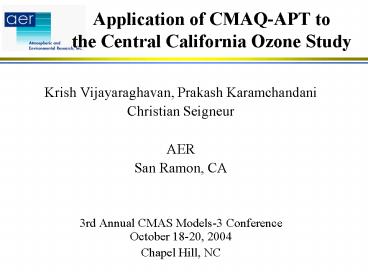Krish Vijayaraghavan, Prakash Karamchandani - PowerPoint PPT Presentation
1 / 21
Title:
Krish Vijayaraghavan, Prakash Karamchandani
Description:
... Surface Ozone 3 p.m. PDT on July 30, 2000 CMAQ Base: Surface HNO3 3 p.m. PDT on July 31, 2000 (Base Background) Surface HNO3 3 p.m. PDT on July 31, 2000 ... – PowerPoint PPT presentation
Number of Views:71
Avg rating:3.0/5.0
Title: Krish Vijayaraghavan, Prakash Karamchandani
1
Application of CMAQ-APT tothe Central California
Ozone Study
- Krish Vijayaraghavan, Prakash Karamchandani
- Christian Seigneur
- AER
- San Ramon, CA
- 3rd Annual CMAS Models-3 ConferenceOctober
18-20, 2004 - Chapel Hill, NC
2
Overview
- Limitations of 3-D grid modeling
- CMAQ-APT Plume-in-grid (PiG) air quality model
- State-of-the science treatment of stack plumes at
the sub-grid scale - 3-D grid host model - CMAQ
- Reactive plume model SCICHEM
- Impact of PiG treatment on ozone and HNO3
concentrations
3
Interface between CMAQ and SCICHEM
Domain, grid information geophysical
data meteorological data deposition velocities
Control File
Emissions, IC/BC
I/O API
I/O API
chemical concentrations
CMAQ
SCICHEM
Point source emissions
I/O API
I/O API
Standard SCICHEM output
Output
Output puff information
Dump puffs
chemical concentrations
Puff diagnostics (process analysis)
4
Improvements to CMAQ-APT
- Optional treatment for the effects of building
downwash on plume rise and dispersion (PRIME) - Incorporation of CMAQ code updates released in
September 2003 (version 4.3) - Incorporation of modifications in SCICHEM version
1601 (January 2004 release) - Young Boris chemistry solver
5
Application to Central California
- Central California Ozone Study (CCOS)
- Ozone episode July 30 to August 1, 2000
- Study domain
- 185 x 185 grid cells
- Horizontal grid resolution of 4 km
- 20 layers from surface to tropopause (surface
layer 30 m)
6
Features of July/August 2000 CCOS episode
- Observed peak ozone during the modeling period
was 134 ppb at San Andreas station on August 1,
2000 - Prevailing winds from the coast to the Central
Valley - Wildfires in the southeast (Tulare County near
the Sierra Nevada)
7
Model Inputs
- Meteorology driven by MM5
- CMAQ emissions, initial and boundary conditions
from CAMx files (ARB) - 3-D gridded emissions using SMOKE plume rise
processor - Ten largest NOx emitting plants (with 56 stacks)
selected for plume-in-grid (PiG) treatment
8
PiG Sources
Top 10 NOx emissions
- Pittsburg power plant
- (16 Mg/day NOx)
- Riverside Cement
- California Cement
- Moss Landing power plant
- Martinez refinery
- Hanson Cement
- Unknown
- Portland Cement
- IMC Chemicals
- Contra Costa power plant
Total 101 Mg/day (4 of domain-wide NOx
emissions)
9
Simulations
- CMAQ base simulation
- All emissions in domain in 3-D gridded format
- CMAQ background simulation
- 3-D gridded emissions without PiG sources
- CMAQ-APT simulation
- 3-D gridded emissions other than PiG sources
- PiG sources treated separately with SCICHEM
10
Extended San Francisco Bay Area
11
CMAQ Base Surface Ozone 3 p.m. PDT on July 30,
2000
12
(Base Background) Surface Ozone 3 p.m. PDT on
July 30, 2000
13
(APT Base) Surface Ozone 3 p.m. PDT on July
30, 2000
14
Evolution of Plume Chemistry
3
2
Long-range Plume Dispersion
Early Plume Dispersion
Mid-range Plume Dispersion
1
Reduced VOC/NOx/O3 chemistry acid formation
from OH and NO3/N2O5 chemistry
NO/NO2/O3 chemistry
Full VOC/NOx/O3 chemistry acid and O3 formation
15
CMAQ Base Surface HNO3 3 p.m. PDT on July 31,
2000
16
(Base Background) Surface HNO3 3 p.m. PDT on
July 31, 2000
17
(APT Base) Surface HNO3 3 p.m. PDT on July 31,
2000
18
Comparison of CMAQ-APT results in CCOS and NARSTO
- CCOS
- APT produces up to 10 ppb lower ozone than Base
- and up to 1.5 ppb lower HNO3
- NARSTO
- APT produces up to 40 ppb lower ozone than Base
- and up to 24 ppb lower HNO3
- (Karamchandani et al., J. Geophys. Res.,107,
4403, 2002) - NOx emissions from PiG sources are about 50 times
higher in NARSTO than in CCOS
19
Conclusions
- CMAQ-APT applied to July/August 2000 CCOS episode
- O3 concentrations using APT show both decrements
(up to 10 ppb) and increments (up to 6 ppb) with
respect to the base - The VOC vs. NOx limited nature of the background
environment explains the differences in O3
production and destruction between the APT and
base results
20
Conclusions
- Surface HNO3 concentrations are up to 1.5 ppb
(about 10) lower in the CCOS APT simulation and
24 ppb lower in the NARSTO APT simulation,
compared to the base cases - Effect of PiG treatment on HNO3 is important for
PM nitrate and regional haze modeling. - PiG treatment for PM (CMAQ-MADRID-APT) is
currently being tested (Karamchandani et al.,
AWMA, October 2004)
21
Acknowledgements
- California Energy Commission
- California Air Resources Board
- EPRI
- Titan/ARAP































